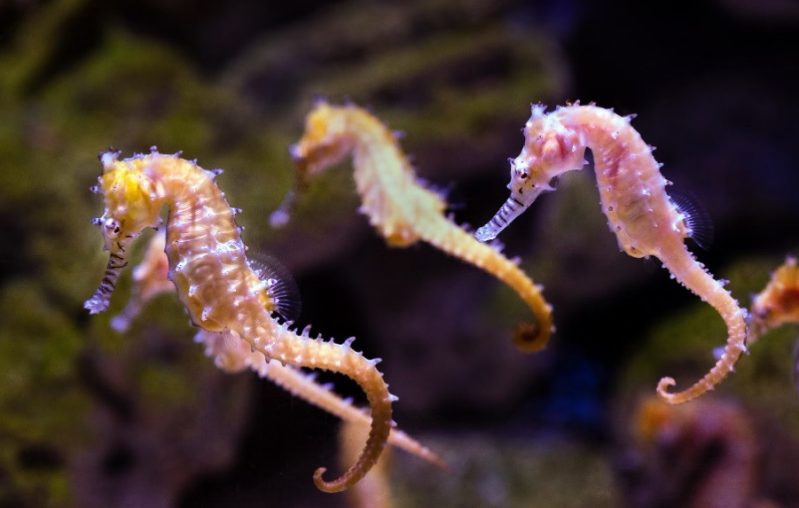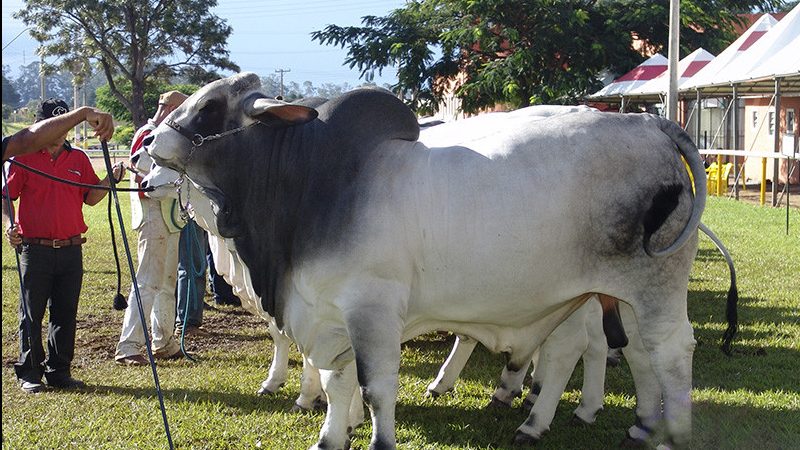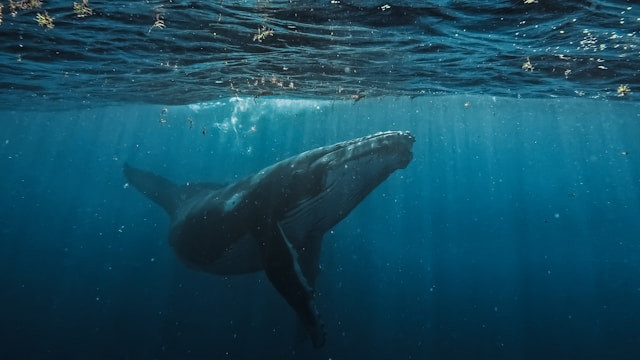The Mysterious Way Seahorse Mating Works

© David Clode / Unsplash
Beneath the surface of the ocean lies a world shrouded in mystery and wonder, where strange creatures and unique behaviors captivate our imagination.
One such enigmatic creature is the seahorse, known for its peculiar appearance and fascinating mating rituals. In comparison, we ourselves are aware of how and who we love. However, the seahorse love tackles a different approach.
From their intricate courtship dances to their bond with their offspring, this is the mystery of seahorse love.
What Are Seahorses?
Seahorses are small fish named for their head shape resembling that of a tiny horse. There are over 50 known species of seahorses.
Each seahorse has a unique appearance, often spotted, speckled, or striped, and adorned with skin frills, spikes, or crowns. They can change colors rapidly for camouflage or to communicate with others.

Seahorses possess flesh-covered bony plates instead of scales, with eyes that move independently. Their prehensile tails grip seafloor holdfasts to prevent drifting and link during courtship. Sizes range from tiny, like a lima bean, to over a foot in length.
Seahorse Habitat
Seahorses prefer calm, shallow waters such as seagrass beds, mangroves, estuaries, and coral reefs worldwide. They move with rapid beats of their dorsal fin (up to 70 times per second), using small pectoral fins for stability. Vulnerable to exhaustion and currents, many perish in stormy seas.
What About Their Diet?
Seahorses are ambush predators, remaining still and capturing krill, copepods, fish larvae, and other small prey with impressive speed. Despite being toothless and lacking a stomach for food storage, they continuously use their long snouts like vacuum cleaners to suck up plankton. This feeding strategy allows them to sustain themselves in their preferred habitats of seagrass beds, mangroves, and coral reefs, where they play a crucial role in marine ecosystems.
The Mystery of Seahorse Love
At sunrise, male and female seahorses meet, gently touching noses and circling each other while making clicking noises. They sway in a graceful dance, seemingly lost in each other’s company, as if to the rhythm of underwater music.

During courtship, seahorses release hormones that can affect their camouflage, causing their bodies to glow and their skin patterns to become more pronounced. Researchers believe this signaling indicates readiness to mate, despite the risks associated with altered camouflage.
What Does the Dancing Do in Seahorse Love?
The first step in deciphering the mystery of seahorse love is their courtship. During courtship, seahorses engage in dances that serve as seduction rituals, often lasting hours. When ready to mate, the female swims upwards and stretches out her body, signaling her readiness. The male responds by pressing his chin against his chest and displaying his prehensile tail, which he uses to pump water into his brood pouch to demonstrate its spaciousness to the female.

Shortly after, the female and male sea horses snuggle closely together and allow themselves to drift upward. They push their bodies close until their noses and stomachs touch. Due to the curves in their body posture, the space between them appears to resemble a heart shape. Then, something incredible happens. A penis-like tubular rod, known as the ovipositor, emerges in the center of the female seahorse’s belly. During the peak of the romantic moment, the couple raises their heads in delight, arching their backs, and the male seahorse receives the female’s eggs into his pouch, where they are fertilized by his sperm.
What Comes Next?
Shortly after mating, the seahorse couple separates, their vibrant colors and patterns fading. The male shakes himself to position the fertilized eggs in his brood pouch, while the female typically swims away to hunt and feed. For the male seahorse, the challenging period of pregnancy now begins as he carries and nurtures the developing embryos.
So, Why Do the Males Get Pregnant?
In 2001, Professor Tony Wilson and colleagues demonstrated that male seahorses provide nutrition to the embryos in their pouches. It’s now clear that male seahorse pregnancy closely resembles that of female mammals.
The male’s immune system protects the embryos from infections, and researchers at the GEOMAR Helmholtz Centre are studying the microbiome in the male’s pouch. The father seahorse transfers beneficial bacteria to the embryos, enhancing their immune systems during development.

Additionally, the pregnant male seahorse expels waste materials from the embryos and supplies them with nutritious, high-energy fats. A process of gaseous exchange allows the embryos to breathe during their development inside the male’s pouch.
How Does the Female’s Eggs Get Fertilized?
Biologists have long assumed that male seahorses fertilize eggs directly in their brood pouches. However, researchers discovered a puzzle with species like the yellow, common, or spotted seahorse (Hippocampus kuda). These males cannot deposit sperm directly into their pouches because their sperm tubes end outside of them.
Similarly, the long-snouted seahorse (Hippocampus guttulatus) and short-snouted seahorse (Hippocampus hippocampus) face anatomical challenges in fertilizing eggs within their pouches. However, one question remains.
How Does the Sperm Reach the Eggs?
Professor William Holt of the University of Sheffield, an expert on seahorse reproduction, suggests that in yellow seahorses, the male emits semen during mating, but the brood pouch opening is too far from the sperm duct for sperm to swim directly.
He speculates that while the female transfers eggs to the male’s pouch with her ovipositor, she also collects sperm from the water, ensuring it enters the pouch along with the eggs. Holt believes this complex process likely applies to other seahorse species as well.

Holt finds it peculiar that seahorses invest so much energy in courtship and mating, especially when females could theoretically spawn in the water like most other fish, allowing males to fertilize eggs independently.
He likens the situation to a hunter loading a rifle only to throw it at a stag, considering the reproductive behavior of yellow seahorses somewhat illogical and unconventional.
Seahorse Monogamy
Seahorses present a significant puzzle with their monogamous behavior. Unlike the vast majority of mammals, amphibians, reptiles, and fish, where lasting partnerships are rare, seahorses are known for their faithful relationships. They engage in loving courtship and invest heavily in their bond, sharing common activities and rarely straying from each other.
In many seahorse species, couples engage daily in greeting rituals and dances, which behavioral scientists believe strengthen their relationship more than sexual activity does. These pairs typically stay together for life, and old stories suggest extraordinary loyalty, where one may follow the other into captivity if caught. Aquarium keepers have observed that after one seahorse dies, the surviving partner often passes away shortly afterward. This raises questions about whether grief could play a role in causing the remaining seahorse to lose its will to live.
Seahorse Facts
Want to learn more about these unique creatures? Here are some fun facts about seahorses:
1. They Actually Can’t Swim!
Seahorses stand out not only in appearance but also in their swimming ability, which is remarkably poor compared to other fish. Their sole means of propulsion is a tiny dorsal fin that beats up to 50 times per second.
Despite this rapid movement, their slow speed is due to the fin’s small size, limiting their ability to cover distance effectively. With the help of small pectoral fins for steering, seahorses remain delicate creatures vulnerable to fatal exhaustion in rough waters, particularly during storms.

2. They Are More Athletic Than You Think!
Despite their slow speed, seahorses show athleticism with their flexible tails, which allow them to anchor to coral or seaweed for rest and even wrap around their mates to stay together.
This tail flexibility also makes them adept hitchhikers, as they can cling to floating vegetation or marine debris to travel to new locations, overcoming their natural limitations in swimming speed.
3. Their Diet Consists of Eating as Much as Possible!
Seahorses have a unique digestive system lacking teeth and a stomach, accelerating their digestion process. They sustain themselves with a carnivorous diet of tiny fish and planktonic copepods, requiring constant feeding.
Despite their small size, seahorses can ingest up to 3,000 crustaceans such as brine shrimp daily, using their trumpet-like snouts to suck prey from distances up to three centimeters away. This reflects their exceptionally high metabolism.
Seahorse Threats
Seahorses face threats from pollution, coastal development, and especially overfishing. Millions are caught annually as bycatch by commercial fishermen, and they are also targeted for dried trinkets and traditional medicine in Asia, posing serious risks to their populations.

As of now, population data for many seahorse species is limited, but scientists believe most are threatened, with some facing rapid declines. The long-term impact of warming seas due to climate change on seahorses remains uncertain.
How Can We Save Them?
To safeguard seahorses, it’s essential to protect their shallow-water habitats from pollution and development, enforce fishing regulations to reduce bycatch, and diminish demand for them in trinkets and traditional medicine.
What do you think of the mystery of seahorse love?
You might also want to read: Reproduction in Space: Is Growing Mouse Embryos Possible?


